steering wheel PEUGEOT 2008 2015 Owners Manual
[x] Cancel search | Manufacturer: PEUGEOT, Model Year: 2015, Model line: 2008, Model: PEUGEOT 2008 2015Pages: 340, PDF Size: 8.4 MB
Page 4 of 340
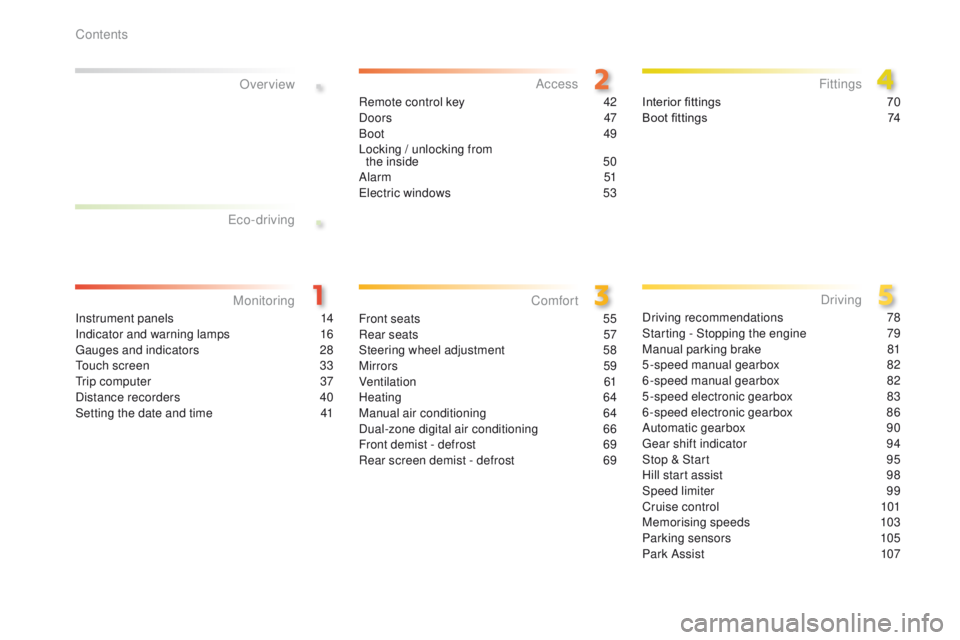
.
.
2008_en_Chap00a_sommaire_ed01-2015
Instrument panels 14
Indicator and warning lamps 1 6
Gauges and indicators
2
8
Touch screen
3
3
Trip computer
3
7
Distance recorders
4
0
Setting the date and time
4
1
MonitoringOver view
Remote control key 4
2
Doors 47
Boot
49
Locking / unlocking from the inside
5
0
Alarm
5
1
Electric windows
5
3Interior fittings
7 0
Boot fittings 7 4
AccessFittings
Front seats 55
Rear seats 5 7
Steering wheel adjustment
5
8
Mirrors
59
Ventilation
61
Heating
64
Manual air conditioning
6
4
Dual-zone digital air conditioning
6
6
Front demist - defrost
6
9
Rear screen demist - defrost
6
9
Comfort
Driving recommendations 78
Starting - Stopping the engine 7 9
Manual parking brake
8
1
5-speed manual gearbox
8
2
6-speed manual gearbox
8
2
5-speed electronic gearbox
8
3
6-speed electronic gearbox
8
6
Automatic gearbox
9
0
Gear shift indicator
9
4
Stop & Start
9
5
Hill start assist
9
8
Speed limiter
9
9
Cruise control
1
01
Memorising speeds
1
03
Parking sensors
1
05
Park Assist
1
07
Driving
Eco-driving
Contents
Page 9 of 340
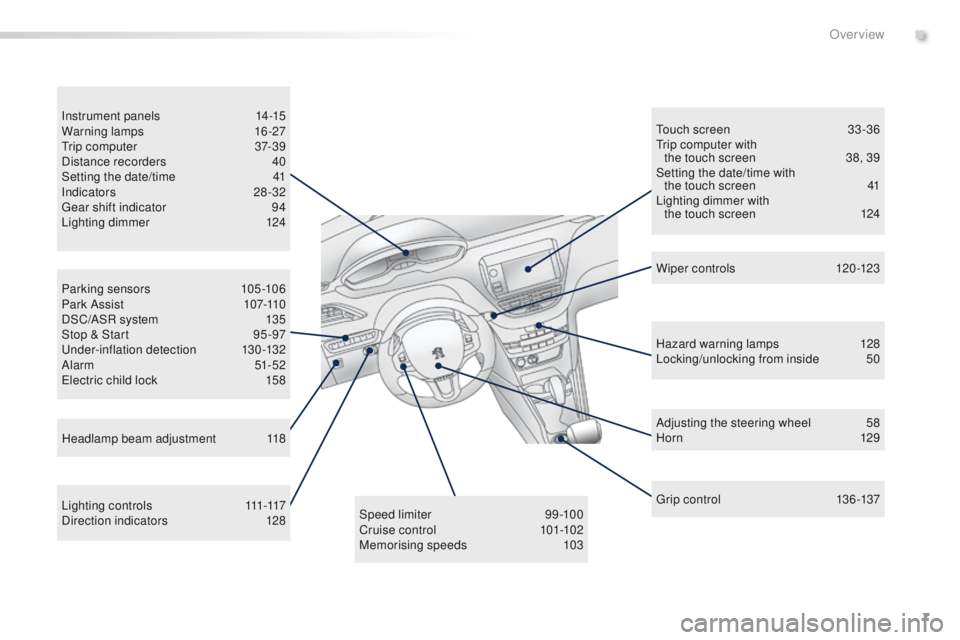
7
2008_en_Chap00b_vue-ensemble_ed01-2015
Parking sensors 105-106
Park Assist 10 7-110
DSC/ASR system
1
35
Stop & Start
9
5 -97
Under-inflation detection
1
30-132
Alarm
51-52
Electric child lock
1
58
Instrument panels
1
4-15
Warning lamps
1
6-27
Trip computer
3
7-39
Distance recorders
4
0
Setting the date/time
4
1
Indicators
2
8-32
Gear shift indicator
9
4
Lighting dimmer
1
24
L i g h t i n g c o n t r o l s
111
-117
Direction indicators
1
28Speed limiter
9
9-100
Cruise control
10
1-102
Memorising speeds
1
03Touch screen
3
3 -36
Trip computer with the touch screen
3
8, 39
Setting the date/time with the touch screen
4
1
Lighting dimmer with the touch screen
1
24
Headlamp beam adjustment
1
18 Wiper controls
1
20-123
Hazard warning lamps
1
28
Locking/unlocking from inside
5
0
Adjusting the steering wheel
5
8
H or n
12
9
G r ip c ontrol
13
6 -137
.
Over view
Page 11 of 340
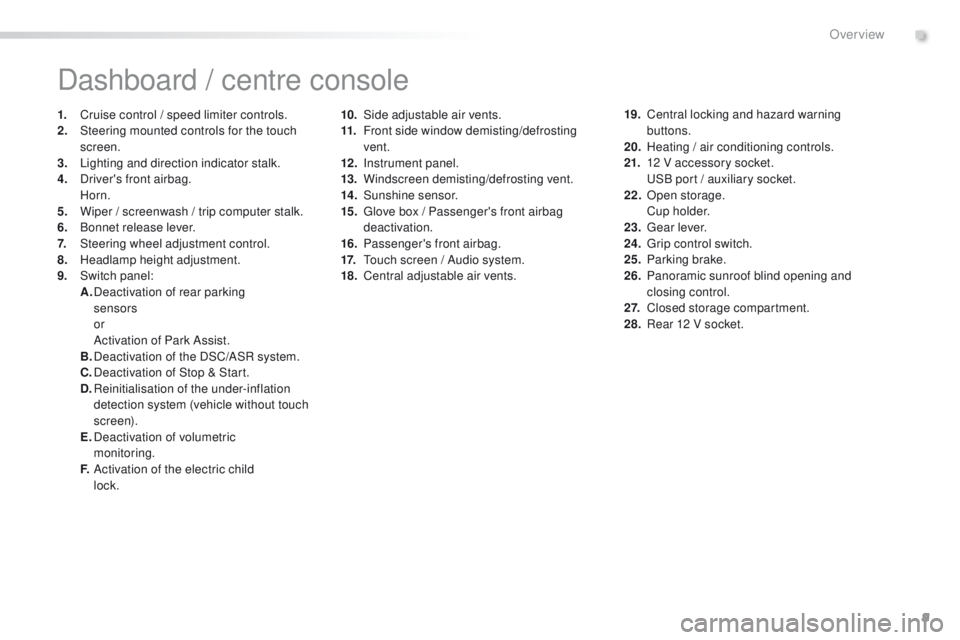
9
2008_en_Chap00b_vue-ensemble_ed01-2015
10. Side adjustable air vents.
11. Front side window demisting/defrosting
vent.
12 .
I
nstrument panel.
13.
W
indscreen demisting/defrosting vent.
14 .
S
unshine sensor.
15.
G
love box / Passenger's front airbag
deactivation.
16.
P
assenger's front airbag.
17.
T
ouch screen / Audio system.
18.
C
entral adjustable air vents.
Dashboard / centre console
1. Cruise control / speed limiter controls.
2. Steering mounted controls for the touch
screen.
3.
L
ighting and direction indicator stalk.
4.
D
river's front airbag.
Horn.
5.
W
iper / screenwash / trip computer stalk.
6.
B
onnet release lever.
7.
S
teering wheel adjustment control.
8.
H
eadlamp height adjustment.
9.
S
witch panel:
A.
D
eactivation of rear parking
sensors
or
A
ctivation of Park Assist.
B.
D
eactivation of the DSC/ASR system.
C.
D
eactivation of Stop & Start.
D.
R
einitialisation of the under-inflation
detection system (vehicle without touch
screen).
E.
D
eactivation of volumetric
monitoring.
F.
A
ctivation of the electric child
lock. 19. C
entral locking and hazard warning
buttons.
20.
H
eating / air conditioning controls.
21.
1
2 V accessory socket.
U
SB port / auxiliary socket.
22.
O
pen storage.
C
u p h o l d e r.
23.
G
ear lever.
24.
G
rip control switch.
25.
P
arking brake.
26.
P
anoramic sunroof blind opening and
closing control.
2 7.
C
losed storage compartment.
28.
R
ear 12 V socket.
.
Over view
Page 39 of 340
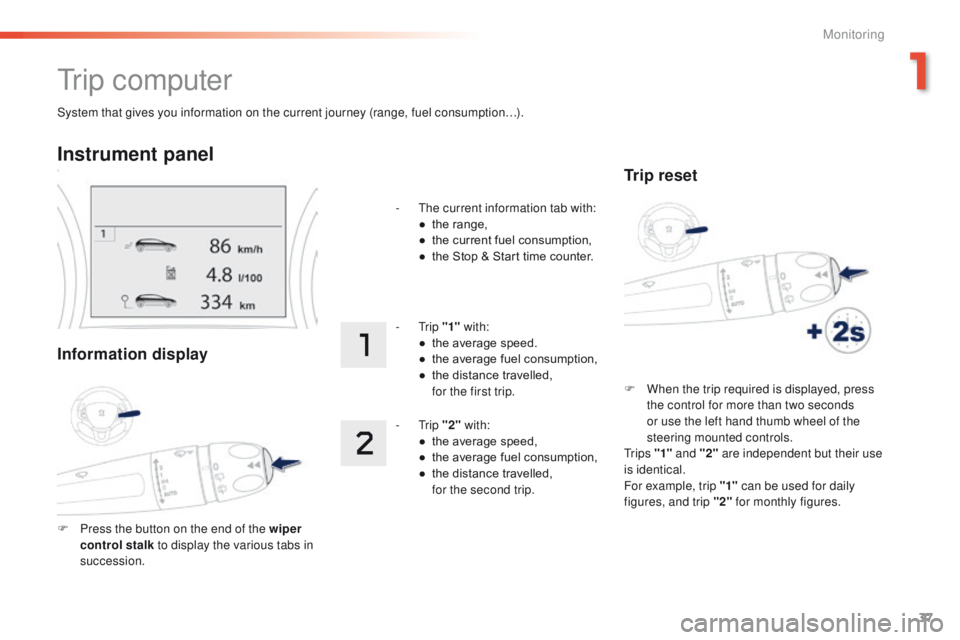
37
2008_en_Chap01_controle-de-marche_ed01-2015
System that gives you information on the current journey (range, fuel consumption…).
Tr i p c o m p u t e r
Instrument panel
Information display
F Press the button on the end of the wiper control stalk to display the various tabs in
succession. -
T
he current information tab with:
●
t
he range,
●
t
he current fuel consumption,
●
t
he Stop & Start time counter.
- Trip
"1" with:
●
t
he average speed.
●
t
he average fuel consumption,
●
t
he distance travelled,
f
or the first trip.
- Trip
"2" with:
●
t
he average speed,
●
t
he average fuel consumption,
●
t
he distance travelled,
f
or the second trip.
Trip reset
F When the trip required is displayed, press
the control for more than two seconds
or use the left hand thumb wheel of the
steering mounted controls.
Tr i p s "1" and "2" are independent but their use
is identical.
For example, trip "1" can be used for daily
figures, and trip "2" for monthly figures.
1
Monitoring
Page 60 of 340
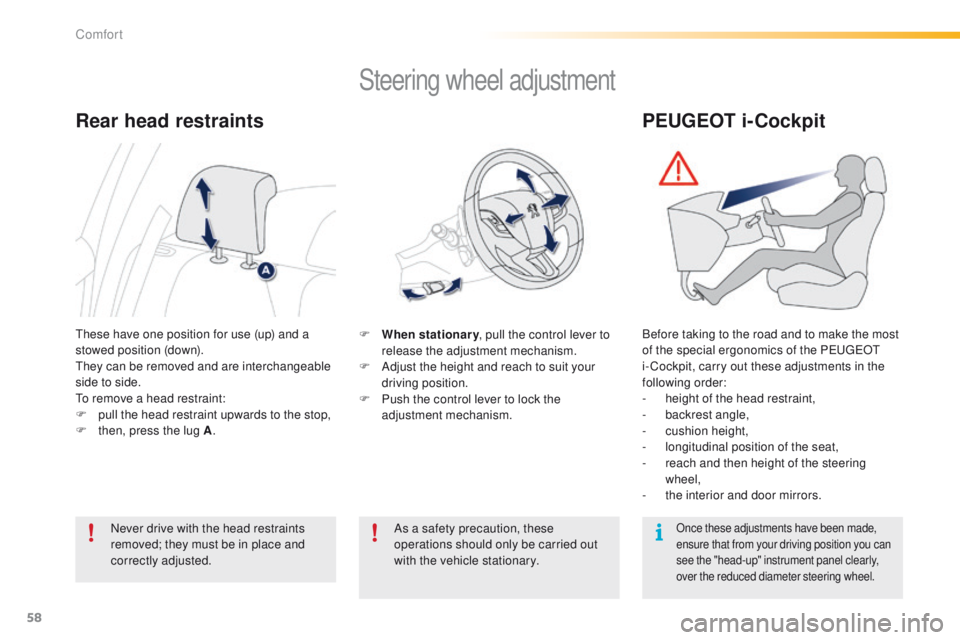
58
2008_en_Chap03_confort_ed01-2015
Steering wheel adjustment
F When stationary, pull the control lever to
release the adjustment mechanism.
F
A
djust the height and reach to suit your
driving position.
F
P
ush the control lever to lock the
adjustment mechanism.
As a safety precaution, these
operations should only be carried out
with the vehicle stationary.
These have one position for use (up) and a
stowed position (down).
They can be removed and are interchangeable
side to side.
To remove a head restraint:
F
p
ull the head restraint upwards to the stop,
F
t
hen, press the lug A .
Rear head restraints
Never drive with the head restraints
removed; they must be in place and
correctly adjusted.
PEUGEOT i-Cockpit
Before taking to the road and to make the most
of the special ergonomics of the PEUGEOT
i- Cockpit, carry out these adjustments in the
following order:
-
h
eight of the head restraint,
-
b
ackrest angle,
-
c
ushion height,
-
l
ongitudinal position of the seat,
-
r
each and then height of the steering
wheel,
-
t
he interior and door mirrors.
Once these adjustments have been made,
ensure that from your driving position you can
see the "head-up" instrument panel clearly,
over the reduced diameter steering wheel.
Comfort
Page 81 of 340
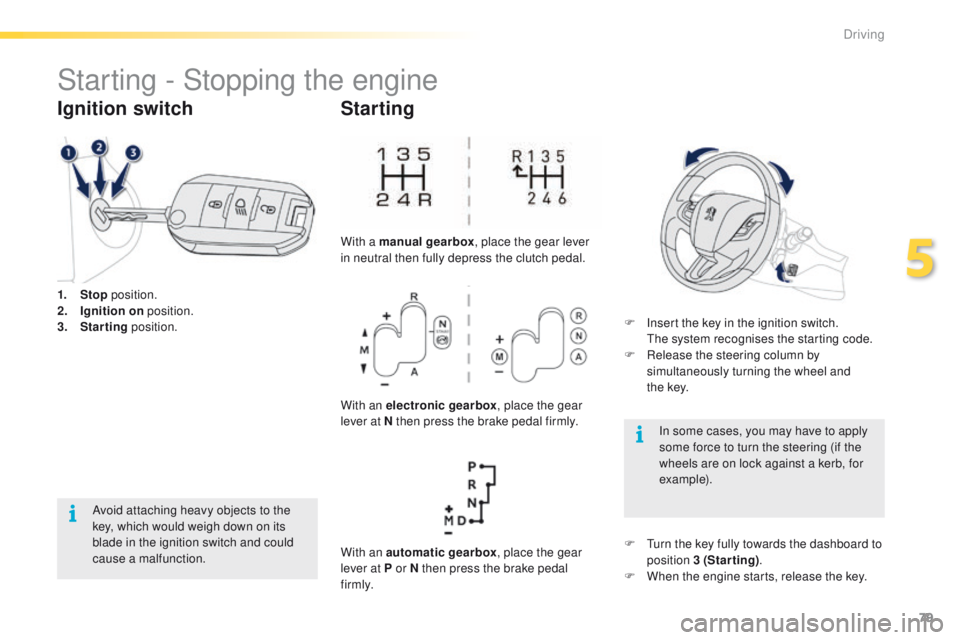
79
2008_en_Chap05_conduite_ed01-2015
Starting - Stopping the engine
1. Stop position.
2. I gnition on position.
3.
S
tarting position.
Ignition switch
Avoid attaching heavy objects to the
key, which would weigh down on its
blade in the ignition switch and could
cause a malfunction.
Starting
With a manual gearbox , place the gear lever
in neutral then fully depress the clutch pedal.
With an electronic gearbox , place the gear
lever at N then press the brake pedal firmly.
With an automatic gearbox , place the gear
lever at P or N then press the brake pedal
f i r m l y. F
I
nsert the key in the ignition switch.
T
he system recognises the starting code.
F
R
elease the steering column by
simultaneously turning the wheel and
t h e
key.
In some cases, you may have to apply
some force to turn the steering (if the
wheels are on lock against a kerb, for
example).
F
T
urn the key fully towards the dashboard to
position 3 (Starting) .
F
W
hen the engine starts, release the key.
5
Driving
Page 82 of 340

80
2008_en_Chap05_conduite_ed01-2015
Key left in the "Ignition on"
position
On opening the driver's door, an alert
message is displayed, accompanied by an
audible signal, to remind you that the key is
still in the ignition switch at position 1 (Stop).
F Immobilise the vehicle.
F
T urn the key fully towards you to position 1
(Stop) .
F
R
emove the key from the ignition switch.
F
T
o lock the steering column, turn the wheel
until the lock engages.
Switching off
If the key has been left in the ignition
switch at position 2 (Ignition on) ,
the ignition will be switched off
automatically after one hour.
To switch the ignition back on, turn the
key to position 1 (Stop) , then back to
position 2 (Ignition on) .
Free-wheeling
For safety reasons, do not free-wheel.
Other wise, some vehicle functions will
no longer be active.
Switching off the engine leads to a loss
of braking assistance.
To facilitate unlocking of the steering
wheel, it is recommended that you
place the wheels in the straight ahead
position before switching off the engine.
Driving
Page 85 of 340

83
2008_en_Chap05_conduite_ed01-2015
Five-speed electronically controlled gearbox
which offers a choice between the comfort of
automatic operation or the pleasure of manual
gear changing.
Three driving modes are offered:
-
a
utomated mode for automatic control
of the gears by the gearbox, without ant
action by the driver.
-
m
anual mode for sequential changing of
the gears by the driver, using the gear lever
or the steering mounted control paddles
-
a
uto sequential mode for overtaking, for
example, remaining in the automated mode
while using the functions of the sequential
mode.
5-speed electronic gearbox
Gear lever
R. Reverse
F W ith your foot on the brake, move the lever
for wards to select this position.
N.
Neutral.
F
W
ith your foot on the brake, select this
position to start the engine.
A.
A
utomated mode.
F
M
ove the lever backwards to select this
mode.
M. + / -
M
anual mode with sequential gear
changing.
F
M
ove the lever backwards, then to the left
to select this mode, then:
-
p
ush for wards to change up a gear,
-
o
r push backwards to change down a gear.
Steering mounted controls
+. Change up paddle.
F P ress the back of the steering wheel "+"
paddle to change up a gear.
-.
C
hange down paddle.
F
P
ress the back of the steering wheel "-"
paddle to change down a gear.
The steering mounted paddles do not
permit the selection of neutral or the
engaging and disengaging of reverse
g e a r.
Do not drive with your hand resting
on the gear lever, as there is a risk of
damaging the gearbox.
5
Driving
Page 109 of 340
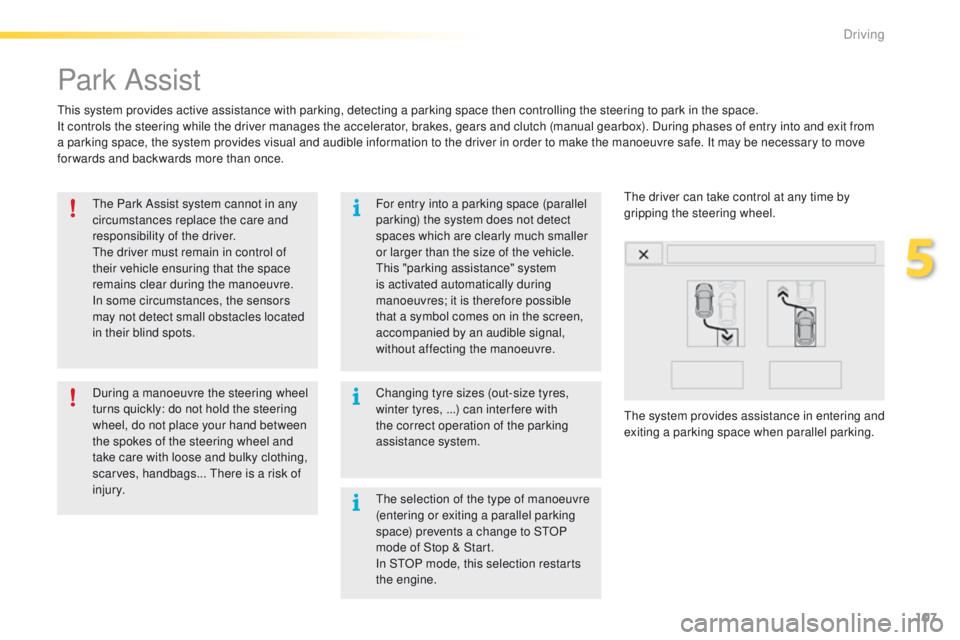
107
2008_en_Chap05_conduite_ed01-2015
Park Assist
This system provides active assistance with parking, detecting a parking space then controlling the steering to park in the space.
It controls the steering while the driver manages the accelerator, brakes, gears and clutch (manual gearbox). During phases of entry into and exit from
a parking space, the system provides visual and audible information to the driver in order to make the manoeuvre safe. It may be necessary to move
forwards and backwards more than once.The Park Assist system cannot in any
circumstances replace the care and
responsibility of the driver.
The driver must remain in control of
their vehicle ensuring that the space
remains clear during the manoeuvre.
In some circumstances, the sensors
may not detect small obstacles located
in their blind spots.
Changing tyre sizes (out-size tyres,
winter tyres, ...) can inter fere with
the correct operation of the parking
assistance system.
During a manoeuvre the steering wheel
turns quickly: do not hold the steering
wheel, do not place your hand between
the spokes of the steering wheel and
take care with loose and bulky clothing,
scarves, handbags... There is a risk of
injury. For entry into a parking space (parallel
parking) the system does not detect
spaces which are clearly much smaller
or larger than the size of the vehicle.
This "parking assistance" system
is activated automatically during
manoeuvres; it is therefore possible
that a symbol comes on in the screen,
accompanied by an audible signal,
without affecting the manoeuvre.
The system provides assistance in entering and
exiting a parking space when parallel parking. The driver can take control at any time by
gripping the steering wheel.
The selection of the type of manoeuvre
(entering or exiting a parallel parking
space) prevents a change to STOP
mode of Stop & Start.
In STOP mode, this selection restarts
the engine.
5
Driving
Page 110 of 340
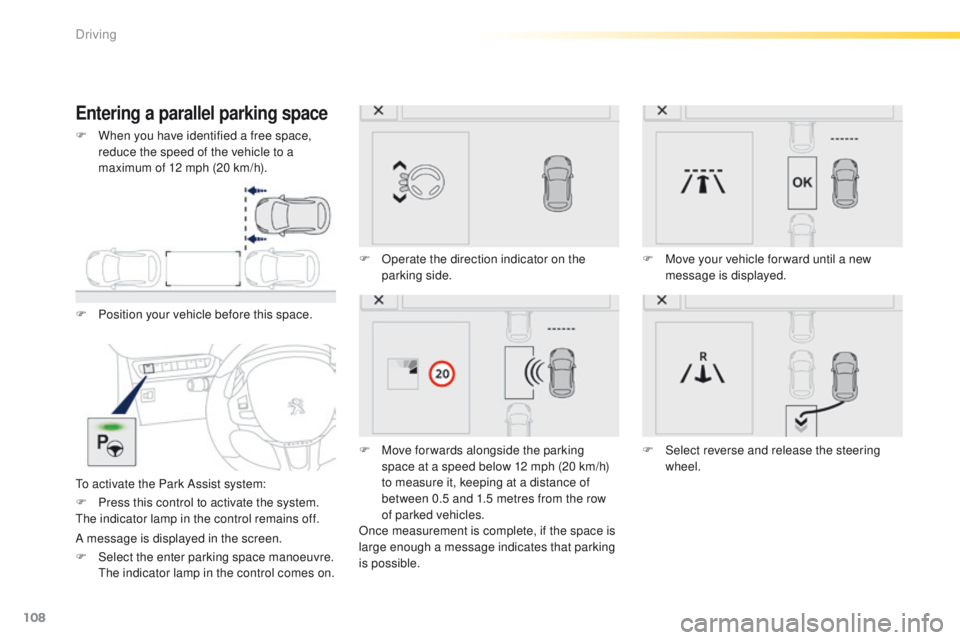
108
2008_en_Chap05_conduite_ed01-2015
Entering a parallel parking space
F Position your vehicle before this space.
To activate the Park Assist system:F
O
perate the direction indicator on the
parking side.
F
M
ove for wards alongside the parking
space at a speed below 12 mph (20 km/h)
to measure it, keeping at a distance of
between 0.5 and 1.5 metres from the row
of parked vehicles.
Once measurement is complete, if the space is
large enough a message indicates that parking
is possible. F
M
ove your vehicle for ward until a new
message is displayed.
F
S
elect reverse and release the steering
wheel.
F
P
ress this control to activate the system.
The indicator lamp in the control remains off.
A message is displayed in the screen.
F
S
elect the enter parking space manoeuvre.
T
he indicator lamp in the control comes on.
F
W
hen you have identified a free space,
reduce the speed of the vehicle to a
maximum of 12 mph (20 km/h).
Driving